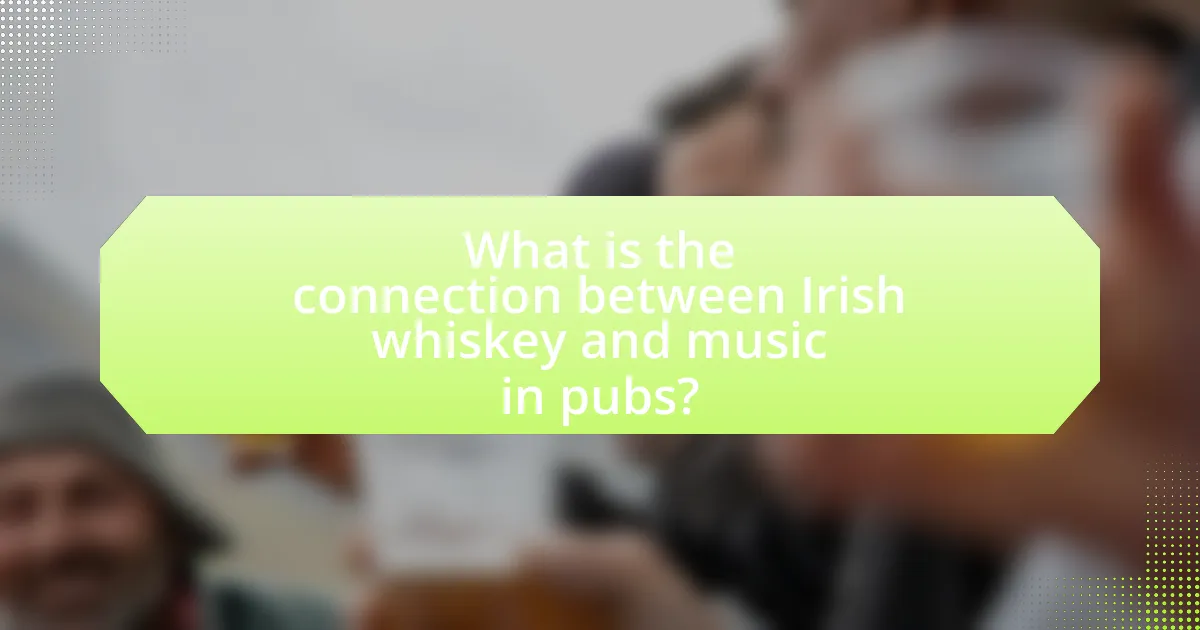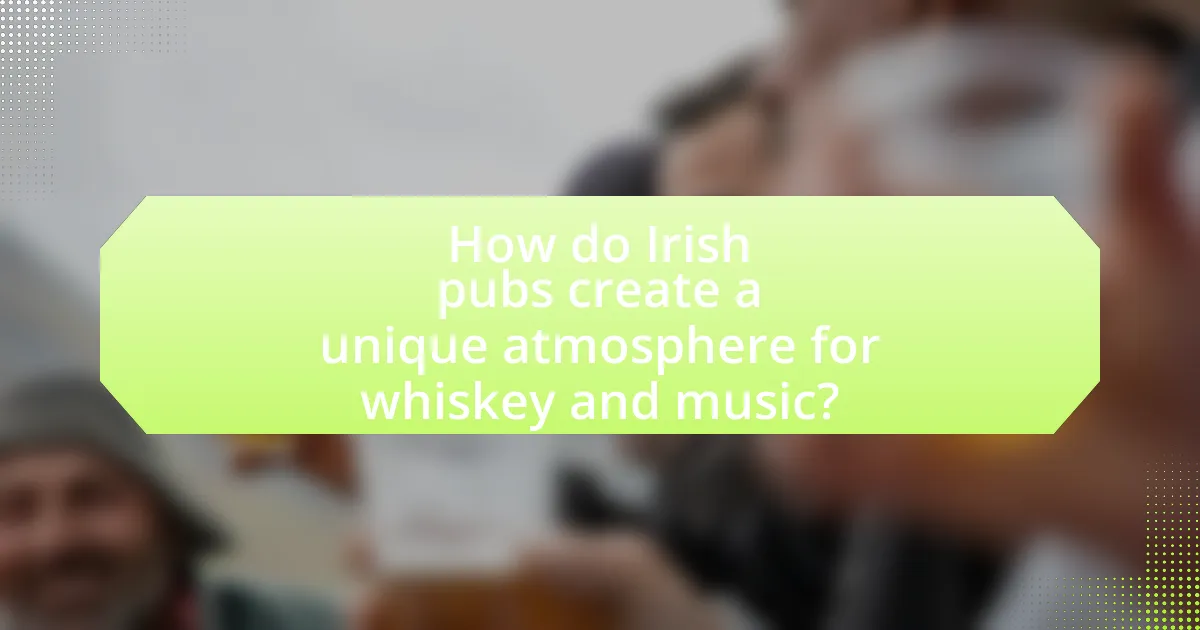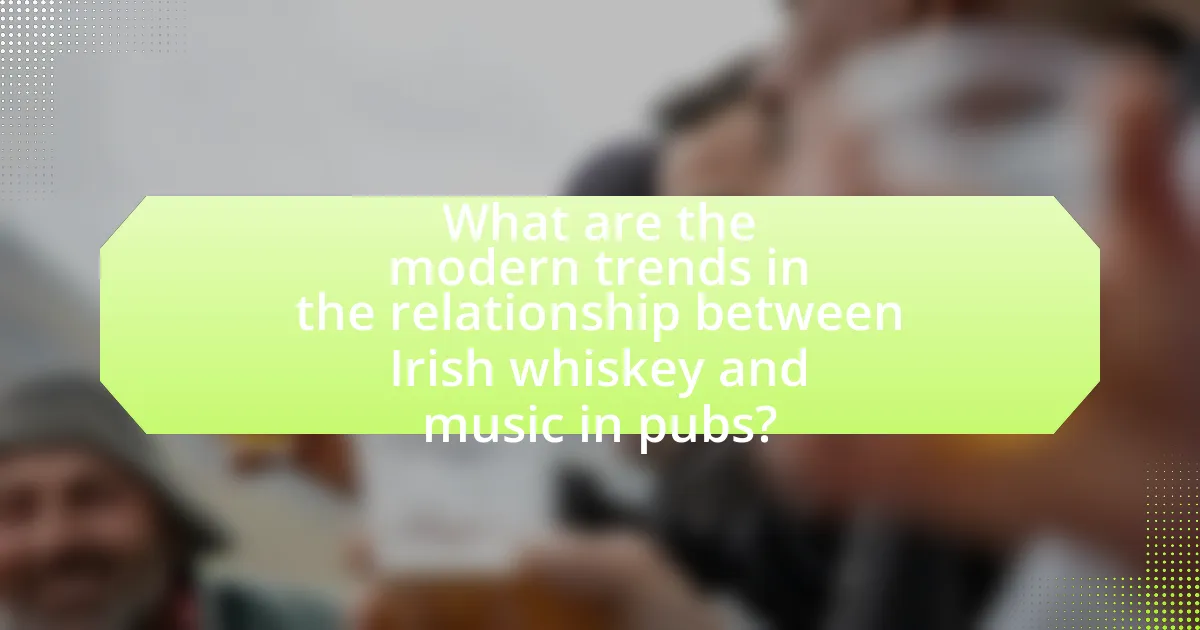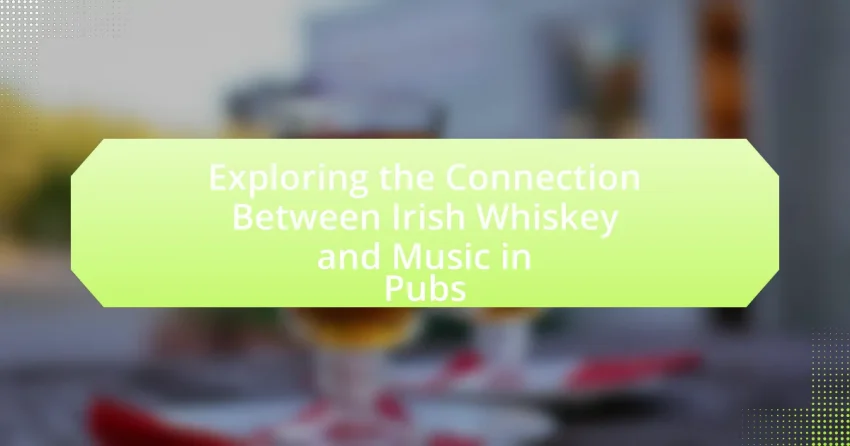The article explores the intrinsic connection between Irish whiskey and music in pubs, highlighting their cultural significance as communal spaces where social interaction flourishes. It examines how whiskey enhances the atmosphere for live music, fostering community bonding and participation in traditional music sessions. The piece also discusses the historical roots of this relationship, the influence of whiskey on musical traditions, and the modern trends shaping the pub experience, including the rise of curated whiskey and music pairings. Additionally, it addresses challenges faced by pubs in maintaining this connection and offers strategies to keep the traditions alive.

What is the connection between Irish whiskey and music in pubs?
Irish whiskey and music in pubs are intrinsically linked through cultural tradition and social experience. In Ireland, pubs serve as communal spaces where people gather to enjoy whiskey while engaging in live music performances, often featuring traditional Irish folk songs. This connection is rooted in the historical significance of pubs as social hubs, where storytelling and music have been integral to Irish culture for centuries. The enjoyment of whiskey enhances the atmosphere, encouraging camaraderie and participation in musical activities, thus reinforcing the cultural identity associated with both whiskey and music in Irish society.
How has Irish whiskey influenced musical traditions in pubs?
Irish whiskey has significantly influenced musical traditions in pubs by creating an atmosphere that encourages social interaction and communal enjoyment. The consumption of Irish whiskey often accompanies traditional music sessions, where patrons gather to listen to or participate in live performances, fostering a sense of community. Historical evidence shows that pubs have long served as cultural hubs in Ireland, where whiskey and music intertwine; for instance, the practice of “seisiún,” informal gatherings of musicians, is often enhanced by the presence of whiskey, which serves to break down social barriers and enhance the overall experience. This relationship is further supported by the fact that many traditional Irish songs reference whiskey, highlighting its role in the cultural narrative and musical expression within pub settings.
What role does whiskey play in the social dynamics of pub music?
Whiskey serves as a catalyst for social interaction and communal bonding in the context of pub music. The act of sharing whiskey often encourages patrons to engage more openly with one another, fostering a lively atmosphere conducive to musical participation. Research indicates that alcohol consumption, including whiskey, can lower inhibitions, leading to increased singing, dancing, and overall enjoyment of live performances. Additionally, whiskey’s cultural significance in Irish tradition enhances its role in pub settings, where it is frequently paired with folk music, creating a shared experience that strengthens social ties among patrons.
How do musicians incorporate whiskey themes into their songs?
Musicians incorporate whiskey themes into their songs by using whiskey as a symbol of camaraderie, nostalgia, and emotional expression. For example, many folk and country songs reference whiskey to evoke feelings of longing or celebration, often depicting social gatherings in pubs where whiskey is consumed. This thematic choice resonates with listeners, as whiskey is culturally significant in Irish music, reflecting the communal experience of sharing stories and songs over drinks. Notable examples include songs like “Whiskey in the Jar,” which narrates tales of love and betrayal, highlighting whiskey’s role in storytelling and emotional connection within the music.
Why is music an essential part of the Irish pub experience?
Music is an essential part of the Irish pub experience because it fosters a sense of community and enhances the atmosphere. Traditional Irish music, often played live, encourages social interaction among patrons, creating a lively and welcoming environment. Historical context shows that music has been integral to Irish culture for centuries, serving as a means of storytelling and cultural expression. The presence of music in pubs not only entertains but also connects people to their heritage, making it a vital component of the overall experience.
What types of music are commonly played in Irish pubs?
Irish pubs commonly feature traditional Irish music, including folk songs, ballads, and instrumental tunes played on instruments such as the fiddle, tin whistle, and bodhrán. This genre reflects Ireland’s rich cultural heritage and is often performed live by musicians, creating an engaging atmosphere for patrons. The prevalence of traditional Irish music in pubs is supported by its historical significance in Irish social gatherings, where music serves as a means of storytelling and community bonding.
How does live music enhance the enjoyment of Irish whiskey?
Live music enhances the enjoyment of Irish whiskey by creating an immersive atmosphere that complements the tasting experience. The combination of rhythmic melodies and the social environment of pubs fosters a sense of community and relaxation, which can heighten the sensory appreciation of the whiskey’s flavors and aromas. Studies have shown that music can influence taste perception; for instance, a study published in the Journal of Experimental Psychology found that background music can enhance the enjoyment of food and drink by affecting mood and emotional responses. Therefore, the presence of live music in pubs not only entertains but also enriches the overall experience of savoring Irish whiskey.
What historical factors contributed to the relationship between whiskey and music in Irish pubs?
The historical relationship between whiskey and music in Irish pubs is primarily rooted in the social and cultural practices of Ireland. Traditionally, Irish pubs served as communal gathering spaces where storytelling, music, and drinking were integral to social life. The introduction of whiskey production in Ireland dates back to the 12th century, with the spirit becoming widely popular by the 18th century, coinciding with the rise of public houses as social hubs.
As whiskey became a staple in these establishments, live music emerged as a form of entertainment that complemented the drinking experience. The Irish folk tradition, characterized by its lively tunes and communal participation, flourished in pubs, creating an atmosphere where patrons would engage in singing and dancing while enjoying whiskey. This synergy between whiskey and music was further solidified during the 19th century, when the Great Famine led to increased emigration, spreading Irish music and whiskey culture globally.
Thus, the historical factors contributing to the relationship between whiskey and music in Irish pubs include the establishment of pubs as social centers, the popularity of whiskey, and the rich tradition of Irish folk music that developed alongside these cultural practices.
How did the rise of Irish whiskey distilleries impact pub culture?
The rise of Irish whiskey distilleries significantly enhanced pub culture by increasing the variety and quality of whiskey available, which in turn attracted more patrons and fostered social interactions. As distilleries proliferated in the 18th and 19th centuries, they produced a diverse range of whiskeys, leading to the establishment of whiskey tasting events and specialized whiskey bars within pubs. This evolution not only elevated the drinking experience but also encouraged the integration of live music and traditional Irish entertainment in pubs, creating a vibrant atmosphere that became synonymous with Irish social life. The historical context shows that by the early 1900s, Irish whiskey was a staple in pubs, contributing to a cultural identity that celebrated both the spirit and the communal experience of drinking.
What historical events shaped the musical landscape of Irish pubs?
The musical landscape of Irish pubs has been shaped significantly by events such as the Great Famine of the 1840s, the Irish War of Independence from 1919 to 1921, and the cultural revival movements in the late 20th century. The Great Famine led to mass emigration, which spread Irish music globally and influenced its evolution. The Irish War of Independence fostered a sense of national identity, with music becoming a medium for expressing cultural pride and resistance. Additionally, the folk revival in the 1960s and 1970s, marked by the rise of traditional Irish music groups, revitalized interest in pub music, solidifying its role as a communal and cultural experience. These events collectively contributed to the rich tapestry of music that characterizes Irish pubs today.

How do Irish pubs create a unique atmosphere for whiskey and music?
Irish pubs create a unique atmosphere for whiskey and music through their traditional design, community-focused environment, and live performances. The warm, inviting interiors often feature wooden furnishings, dim lighting, and decorative elements that reflect Irish culture, enhancing the overall experience of enjoying whiskey. Additionally, the communal aspect of Irish pubs encourages social interaction, making patrons feel connected while they savor their drinks. Live music, often featuring traditional Irish instruments and folk songs, further enriches the ambiance, creating a lively yet intimate setting that celebrates both whiskey and music. This combination of physical space, social dynamics, and cultural expression solidifies the distinctive atmosphere found in Irish pubs.
What elements contribute to the ambiance of an Irish pub?
The ambiance of an Irish pub is primarily shaped by elements such as traditional decor, live music, and a warm, inviting atmosphere. Traditional decor often includes wooden furnishings, dim lighting, and memorabilia that reflect Irish culture and history, creating a cozy environment. Live music, particularly traditional Irish folk music, enhances the social experience and fosters a sense of community among patrons. Additionally, the presence of friendly staff and the aroma of hearty food and drinks, especially Irish whiskey, contribute to the overall welcoming vibe. These elements collectively create a unique and engaging atmosphere that is characteristic of Irish pubs.
How does the interior design of a pub influence musical performances?
The interior design of a pub significantly influences musical performances by affecting acoustics, audience engagement, and overall atmosphere. For instance, materials such as wood and fabric can enhance sound quality by reducing echo, while layout choices like stage placement can improve visibility and interaction between performers and patrons. Research indicates that venues with thoughtful design elements, such as optimal seating arrangements and soundproofing, can lead to higher audience satisfaction and increased attendance at musical events. This correlation between design and performance quality underscores the importance of creating an inviting and acoustically favorable environment in pubs to enhance the musical experience.
What role does lighting play in enhancing the whiskey and music experience?
Lighting plays a crucial role in enhancing the whiskey and music experience by creating an inviting atmosphere that complements the sensory elements of both. Proper lighting can evoke emotions, set the mood, and influence the perception of taste and sound. For instance, warm, dim lighting often encourages relaxation and social interaction, which can enhance the enjoyment of whiskey tasting and live music performances. Studies have shown that ambient lighting can affect mood and perception; for example, a study published in the Journal of Consumer Research found that softer lighting can lead to a more enjoyable dining and drinking experience, thereby enhancing the overall enjoyment of whiskey in a musical setting.
How do patrons interact with whiskey and music in pubs?
Patrons interact with whiskey and music in pubs by enjoying whiskey while engaging with live or recorded music, creating a social and immersive atmosphere. This interaction enhances the overall experience, as whiskey tasting often complements the mood set by the music, whether it is traditional Irish folk or contemporary genres. Research indicates that music can influence the perception of taste, making whiskey seem more enjoyable when paired with the right musical backdrop. For instance, a study published in the Journal of Consumer Research found that background music can alter the flavor perception of beverages, suggesting that the combination of whiskey and music in pubs is not only a cultural practice but also a sensory enhancement.
What are common rituals or traditions involving whiskey and music in pubs?
Common rituals involving whiskey and music in pubs include toasting, live music sessions, and storytelling. In many Irish pubs, patrons often raise their glasses in a toast before drinking, which fosters camaraderie and connection. Live music sessions, featuring traditional Irish instruments like the fiddle and bodhrán, are a staple in pubs, creating an atmosphere that encourages patrons to enjoy whiskey while engaging with the music. Additionally, storytelling is a cherished tradition, where musicians and patrons share tales that often accompany the enjoyment of whiskey, enhancing the cultural experience. These practices are rooted in Irish heritage, emphasizing the social and communal aspects of enjoying whiskey and music together.
How do audience reactions shape live music performances in pubs?
Audience reactions significantly shape live music performances in pubs by influencing the energy and direction of the performance. Musicians often adjust their setlists, tempo, and engagement based on the audience’s responses, such as applause, dancing, or vocal participation. For instance, a study by the University of Edinburgh found that performers are more likely to play upbeat songs when the audience shows enthusiasm, creating a feedback loop that enhances the overall experience. This dynamic interaction not only affects the musicians’ choices but also fosters a communal atmosphere, making the performance more memorable for both the audience and the artists.

What are the modern trends in the relationship between Irish whiskey and music in pubs?
Modern trends in the relationship between Irish whiskey and music in pubs include the rise of curated whiskey and music pairings, where establishments create specific playlists or live performances that complement the tasting experience of various whiskey brands. This trend is supported by the increasing popularity of whiskey tasting events that feature local musicians, enhancing the overall ambiance and cultural experience. Additionally, many pubs are now incorporating traditional Irish music sessions alongside contemporary genres, appealing to a broader audience and fostering a communal atmosphere that celebrates both the heritage of Irish whiskey and the vibrancy of live music.
How are contemporary musicians influencing the Irish pub scene?
Contemporary musicians are significantly influencing the Irish pub scene by revitalizing traditional music styles and attracting diverse audiences. These artists often blend traditional Irish music with modern genres, creating a fusion that appeals to both locals and tourists. For instance, bands like The High Kings and artists such as Hozier incorporate contemporary elements into their music while honoring Irish heritage, which enhances the cultural experience in pubs. This evolution not only keeps the traditional music alive but also encourages younger generations to engage with Irish culture, thereby sustaining the pub’s role as a social and cultural hub.
What new genres are emerging in Irish pubs today?
New genres emerging in Irish pubs today include fusion genres that blend traditional Irish music with contemporary styles such as folk-rock, indie, and electronic music. This evolution reflects a growing trend where musicians incorporate modern instruments and production techniques while maintaining the essence of Irish musical heritage. For instance, artists like Hozier and Lisa Hannigan exemplify this blend, attracting diverse audiences and revitalizing the pub music scene.
How do modern whiskey brands collaborate with musicians?
Modern whiskey brands collaborate with musicians primarily through sponsorships, co-branded events, and exclusive product lines. For instance, brands like Jameson have partnered with artists to create unique experiences, such as music festivals or concerts that feature live performances, enhancing brand visibility and cultural relevance. Additionally, some whiskey brands release limited-edition bottles that are designed in collaboration with musicians, often reflecting the artist’s style or music genre, which appeals to both whiskey enthusiasts and music fans. This strategy not only promotes the whiskey but also strengthens the brand’s association with the music community, as seen in campaigns that highlight the shared values of craftsmanship and creativity.
What challenges do pubs face in maintaining the whiskey and music connection?
Pubs face several challenges in maintaining the whiskey and music connection, primarily due to changing consumer preferences and economic pressures. The rise of craft cocktails and non-alcoholic beverages has shifted customer focus away from traditional whiskey offerings, leading to decreased sales. Additionally, the cost of live music performances can be prohibitive, as many pubs struggle to attract and retain talented musicians while managing operational costs. Furthermore, regulatory issues, such as noise ordinances and licensing requirements, can limit the ability of pubs to host live music events, thereby weakening the connection between whiskey and music. These factors collectively hinder the ability of pubs to create an engaging atmosphere that celebrates both whiskey and live music.
How is the rise of digital music affecting live performances in pubs?
The rise of digital music is diminishing the frequency and appeal of live performances in pubs. As digital platforms provide easy access to a vast library of music, patrons often prefer listening to recorded tracks rather than attending live shows. This shift has led to a decline in audience turnout for live performances, with a 2019 survey indicating that 60% of pub-goers favored digital music over live acts. Consequently, pubs are experiencing reduced revenue from live music events, prompting some to cut back on hosting live performances altogether.
What strategies can pubs use to keep the whiskey and music tradition alive?
Pubs can keep the whiskey and music tradition alive by hosting regular live music events that feature traditional Irish musicians. This strategy not only attracts patrons but also creates an authentic atmosphere that celebrates the cultural heritage associated with whiskey and music. For instance, pubs that schedule weekly sessions with local bands or solo artists can foster a community around these traditions, as evidenced by the success of venues like The Cobblestone in Dublin, which is renowned for its commitment to traditional Irish music. Additionally, offering whiskey tasting events paired with music can enhance the experience, allowing patrons to appreciate the nuances of different whiskey varieties while enjoying live performances. This dual approach reinforces the connection between whiskey and music, ensuring that both traditions thrive in the pub environment.
What tips can enhance the experience of enjoying whiskey and music in Irish pubs?
To enhance the experience of enjoying whiskey and music in Irish pubs, patrons should focus on selecting high-quality whiskey and engaging with live music performances. Choosing a well-regarded whiskey, such as Jameson or Redbreast, can elevate the tasting experience due to their rich flavors and heritage. Engaging with live music, which is a staple in Irish pubs, allows for a deeper connection to the cultural atmosphere, as traditional Irish music often complements the enjoyment of whiskey. Research indicates that the combination of music and alcohol can enhance sensory experiences, making the overall ambiance more enjoyable.
